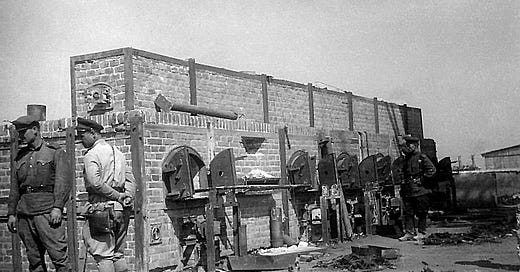Majdanek: 'The most terrible place on the face of the earth'
On August 27, 1944, a group of about 30 American and British correspondents got a firsthand look at the remnants of the atrocities committed by Germany against European civilians.
"I have just seen the most terrible place on the face of the earth -- the German concentration camp at Majdanek, which was a veritable River Rouge for the production of death, in which it is estimated by Soviet and Polish authorities that as many as 1,500,000 persons from nearly every country in Europe were killed in the last three years," wrote W.H. Lawrence in his front-page New York Times story.
The Majdanek facility — described as an “annihilation camp” by John Evans of Reuters — was located outside Lublin, Poland. It opened in the fall of 1941 and operated with increasingly horrifying efficiency until the Red Army arrived on July 24, 1944. Its existence was no secret; Majdanek is mentioned occasionally in U.S. newspaper dispatches for months before the liberation, usually in Jewish or Catholic publications.
But because it was the first of the major Nazi death camps liberated by Allied forces, it offered the first chance for the press to examine the infrastructure of Germany's industrialized killing machinery.
Evans was appalled to hear about the 3,000-degree incinerators employed at the camp and found himself unable to look at the shelves full of children’s toys and clothing that had been confiscated from the victims and stockpiled to be redistributed to Hitler Youth and other “respectable citizens.”
Associated Press correspondent Daniel De Luce described the camp as a “ghastly fantasy.”
"It was established for murder on a vast but methodical scale,” he wrote. “Until a group of American and British correspondents visited it today -- with its six concrete vaults for execution by cyanide or carbon monoxide gas, its open air crematorium surrounded with skeletons, its mounds of human ashes mixed with manure for fertilizing cabbage patches and its overflow burial ground in a pine woods carpeted with decaying bodies -- most of these newspaper men could not even begin to imagine the proportions of its frightfulness."
De Luce's story quoted extensively from a hearing the correspondents attended the same day, at which three SS officers and a German civilian who had been a prisoner at the camp testified in graphic detail to the "scenes of slaughter" that took place at Majdanek.
Lawrence's account relied more on his own observations, as he methodically ticked off the unspeakable details of the operation that are as familiar to us now as the names Auschwitz and Buchenwald but in 1944 must have been difficult for readers to fathom. The correspondent understood that, and addressed it directly in his story.
"This is a place that must be seen to be believed," he wrote. "I have been present at numerous atrocity investigations in the Soviet Union, but never have I been confronted with such complete evidence, clearly establishing every allegation made by those investigating German crimes.
"After inspection of Majdanek, I am now prepared to believe any story of German atrocities, no matter how savage, cruel and depraved."




